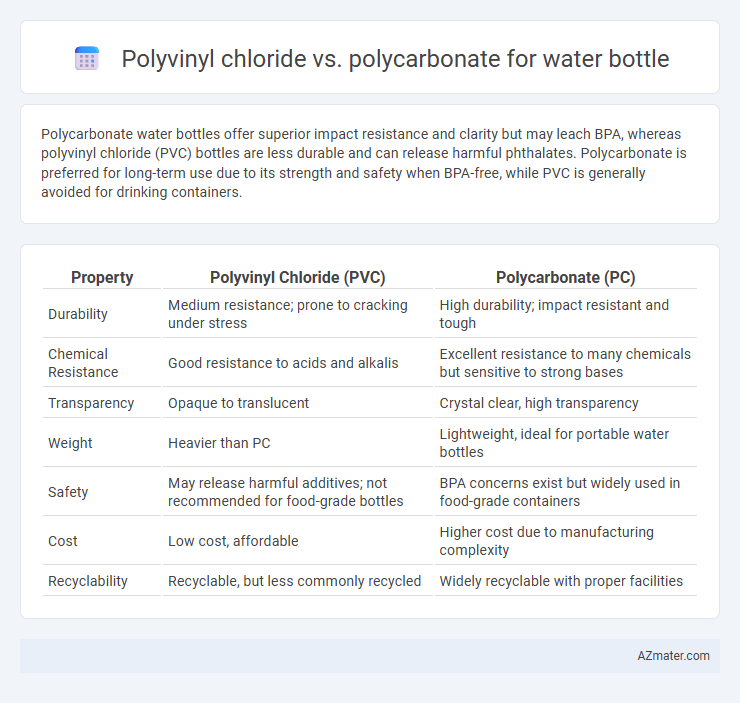Polycarbonate water bottles offer superior impact resistance and clarity but may leach BPA, whereas polyvinyl chloride (PVC) bottles are less durable and can release harmful phthalates. Polycarbonate is preferred for long-term use due to its strength and safety when BPA-free, while PVC is generally avoided for drinking containers.
Table of Comparison
| Property | Polyvinyl Chloride (PVC) | Polycarbonate (PC) |
|---|---|---|
| Durability | Medium resistance; prone to cracking under stress | High durability; impact resistant and tough |
| Chemical Resistance | Good resistance to acids and alkalis | Excellent resistance to many chemicals but sensitive to strong bases |
| Transparency | Opaque to translucent | Crystal clear, high transparency |
| Weight | Heavier than PC | Lightweight, ideal for portable water bottles |
| Safety | May release harmful additives; not recommended for food-grade bottles | BPA concerns exist but widely used in food-grade containers |
| Cost | Low cost, affordable | Higher cost due to manufacturing complexity |
| Recyclability | Recyclable, but less commonly recycled | Widely recyclable with proper facilities |
Introduction to Polyvinyl Chloride (PVC) and Polycarbonate (PC)
Polyvinyl Chloride (PVC) is a versatile thermoplastic polymer characterized by its chemical resistance, durability, and affordability, commonly used in packaging and construction materials, including water bottles with a focus on cost-effectiveness. Polycarbonate (PC) is a high-performance engineering plastic known for its exceptional impact resistance, clarity, and heat resistance, making it ideal for reusable water bottles that require transparency and durability. Comparing PVC and PC for water bottles highlights differences in safety, environmental impact, and long-term usability, with PC often preferred for BPA-free and robust applications.
Chemical Composition and Structure
Polyvinyl chloride (PVC) consists of repeating vinyl chloride monomers with chlorine atoms bonded to its carbon backbone, providing rigidity and chemical resistance but potential leaching concerns in water bottles. Polycarbonate (PC) is composed of bisphenol A (BPA) units connected by carbonate groups, yielding a transparent, impact-resistant polymer known for high durability and BPA-related safety scrutiny. The differing chemical structures influence their thermal stability, flexibility, and safety profiles, making polycarbonate preferred for shatterproof, clear bottles, while PVC is less common due to potential chemical migration issues.
Durability and Strength Comparison
Polycarbonate water bottles exhibit superior durability and impact resistance compared to polyvinyl chloride (PVC), making them less prone to cracking or breaking under stress. Polycarbonate also maintains structural integrity over a wider temperature range, while PVC tends to become brittle when exposed to extreme cold or heat. The higher tensile strength of polycarbonate ensures longer-lasting performance in demanding conditions, making it the preferred choice for robust water bottle applications.
Safety and Health Implications
Polyvinyl chloride (PVC) water bottles often contain phthalates and other plasticizers, which can leach harmful chemicals and pose health risks such as endocrine disruption. Polycarbonate bottles, made from BPA-containing materials, have faced scrutiny due to BPA's potential impacts on hormonal balance, though BPA-free options are now more common. Choosing BPA-free polycarbonate over PVC can reduce exposure to toxic substances, offering a safer and healthier alternative for water storage.
Environmental Impact and Sustainability
Polyvinyl chloride (PVC) water bottles raise environmental concerns due to their production process, which releases harmful dioxins and involves non-recyclable additives, leading to persistent landfill waste and potential toxicity. Polycarbonate water bottles offer greater durability and recyclability but pose risks from Bisphenol A (BPA) leaching, which affects human health and complicates sustainability efforts. Choosing polycarbonate over PVC reduces long-term environmental persistence and improves resource recovery, although safer BPA-free alternatives are preferable for maximizing environmental sustainability.
Cost and Affordability Analysis
Polyvinyl chloride (PVC) water bottles are generally more affordable than polycarbonate (PC) bottles due to lower raw material and manufacturing costs, making PVC a popular choice for budget-sensitive consumers. Polycarbonate bottles offer superior durability and impact resistance but come at a higher price point, impacting overall affordability for mass-market use. Cost analysis typically favors PVC for disposable or short-term use, while polycarbonate is preferred in long-term, reusable water bottles despite its premium cost.
Transparency and Aesthetic Appeal
Polycarbonate water bottles offer superior transparency compared to polyvinyl chloride (PVC), allowing for a clear, glass-like appearance that enhances aesthetic appeal. Polycarbonate's high optical clarity and resistance to yellowing make it ideal for sleek, modern designs. In contrast, PVC tends to have a hazier finish and may degrade visually over time, reducing its attractiveness for stylish water bottles.
Temperature Resistance and Usage Limits
Polycarbonate water bottles exhibit superior temperature resistance, withstanding boiling water up to 135degC without deformation, whereas polyvinyl chloride (PVC) typically degrades around 80-90degC, limiting its use for hot liquids. Polycarbonate's durability and clarity make it ideal for reusable bottles exposed to varying temperatures, while PVC is more suitable for disposable or cold liquid containers due to potential leaching and lower heat tolerance. Usage limits for PVC also include concerns over chemical safety when exposed to heat, making polycarbonate the preferred choice for temperature-critical applications.
Recyclability and End-of-Life Considerations
Polycarbonate water bottles offer higher recyclability through specialized processes that recover BPA-containing plastics, while polyvinyl chloride (PVC) poses greater challenges due to the release of toxic chemicals during recycling and incineration. End-of-life considerations favor polycarbonate since its recycling streams are better established in municipal programs, whereas PVC often ends up in landfills because of limited recycling infrastructure and environmental hazards. Choosing polycarbonate supports a more circular economy for water bottles by reducing harmful waste and enabling material recovery.
Final Verdict: Choosing the Best Material for Water Bottles
Polycarbonate water bottles are preferred for their durability, clarity, and BPA-free safety, making them ideal for long-term use and repeated washings. Polyvinyl chloride (PVC) bottles, while cheaper, often pose health risks due to potential chemical leaching and are less environmentally friendly. For the best balance of safety, performance, and sustainability, polycarbonate stands out as the superior material for water bottles.

Infographic: Polyvinyl chloride vs Polycarbonate for Water bottle
 azmater.com
azmater.com